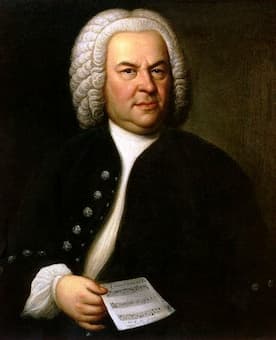
Johann Sebastian Bach
I love all kinds and styles of music, but my true love belongs to classical music. Whether it is Liszt or Mozart, Schubert or Handel, Monteverdi or Mahler, the universe of classical music seems endless. Sometimes my schoolmates want to know who is the best and greatest composer of Western classical music, and my answer is always the same, Johann Sebastian Bach. For me personally, he is the greatest of them all. This means no disrespect to all the other wonderful composers, but Johann Sebastian Bach represents to me the perfect balance of intellect and emotion. And what is more, he communicates a deep level of spirituality and understanding of what it means to be human in every single composition. Johann Sebastian Bach was supremely confident in his musical craft, and self-assured in his handling of musical styles. In addition, he was keenly aware of the emotional and spiritual impact of his music, and he had great humility in his faith. All these traits are wrapped into some of the most gorgeous music ever conceived in this world. When I first decided to make a personal top 10 list of music by the great Johann Sebastian Bach, I thought it might be a horribly difficult task. But it turned out to be super easy because there is no actual difference in quality from one gorgeous piece to the next. Here then is my personal top 10 list of music by the great Johann Sebastian Bach. Coming in at number 10, representatively, is one of Bach’s most gorgeous church cantatas, Herz und Mund und Tat und Leben (Heart and Mouth and Deed and Life).
Johann Sebastian Bach: Herz und Mund und Tat und Leben, BWV 147 (Jane Bryden, soprano; Jeffrey Thomas, tenor; Drew Minter, counter-tenor; Jan Opalach, bass-baritone; The Bach Ensemble; Joshua Rifkin, cond.)

Statue of J.S. Bach in Leipzig
Bach composed this cantata during his tenure in Weimar, but it was first performed in Leipzig, on 2 July 1723. In all, this gorgeous cantata contains ten movements that alternate recitatives and arias, and two of the most stunningly beautiful chorale settings, ever. Can you believe that Bach almost did not get the job as Thomaskantor at Leipzig? The head of the search committee wrote, “since we cannot get the best—Telemann and Graupner had declined the offer—we will have to settle for average.” That average guy turned out to be Johann Sebastian Bach, who almost immediately got into trouble with church authorities. Bach was really frustrated and quickly started looking for a new job. Luckily for us, Bach’s frustration translated into an astonishing level of productivity. Week in and week out he composed or compiled a new cantata, with roughly 100 such works written in his first two years in office. Coming in at number 9 is one of Bach’s most refined orchestral compositions, the Orchestra Suite No. 4.
Johann Sebastian Bach: Orchestra Suite No. 4 in D major, BWV 1069 (Bach Collegium Japan; Masaaki Suzuki, cond.)
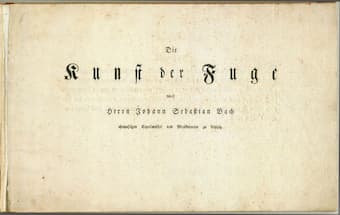
Title page of The Art of Fugue
When Johann Sebastian Bach took on the position of director of the “Collegium Musicum” he was in charge of an ensemble of professional musicians and university students. Judging from the music he wrote for the ensemble, he had musicians with phenomenal technical abilities at his disposal. Sadly, many of Bach’s orchestral compositions seem to have been lost, but luckily 4 Orchestral Suites have survived. The basic Suite opens with a French-style overture and is followed by a collection of dances. This basic architecture is infused with the spirit of dance, expressions of joy, felicity, sorrow, or devotion. The fourth orchestral suite is particularly festive, adding trumpets, timpani, and oboes to a full complement of strings. Sitting at number 8 in my personal top 10 is Bach’s Art of Fugue.
Johann Sebastian Bach: Art of Fugue, BWV 1080 (Richard Troeger, clavichord; Paulette Grundeen, clavichord)
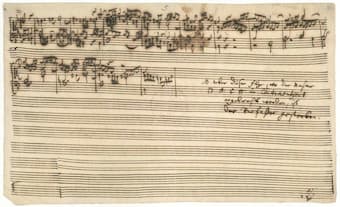
Bach’s unfinished Fugue
Late in Bach’s life, counterpoint and all those strict rules of writing music were considered seriously old-fashioned. As critic wrote, the writing of “fugue are exercises in a dead language.” For Bach, the ideas about music and culture had changed dramatically, but that did not prevent him from composing his most celebrated collection of contrapuntal movements. It’s absolutely amazing, but in The Art of the Fugue, Johann Sebastian Bach explores the possibilities of a single musical theme. Bach showcases every compositional method and technique known at the time, and he was seemingly very proud of his achievement. In theory, it all sounds pretty boring, but each counterpoint is not only a technical masterpiece, but also a highly expressive piece of music. Sadly, Bach was not able to finish the collection because he died right in the middle of a movement. Coming in at number 7 is the fantastically beautiful Cello Suite No. 2.
Johann Sebastian Bach: Cello Suite No. 2 in D minor, BWV 1008
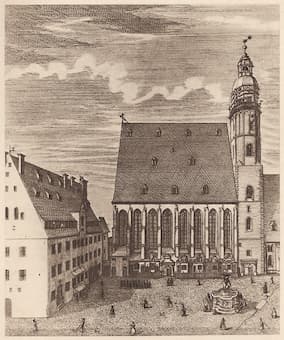
Saint Thomas Church in Leipzig
When Bach was working, the cello was a comparatively new instrument. It had developed from the soft-voiced family of viols, and the cello was strictly confined to playing the bass line. Bach wasn’t the first composer who employed the cello in a soloist capacity, but his compositions for solo cello are unmatched. Bach’s 6 Solo cello suites follow the traditional form of the German instrumental suite. That means, that an elaborate prelude is followed by a fixed series of dances. Personally, I just love the second suite as it is written in a minor key. A scholar writes, “the passionate and penetrating energy, the inner fire and warmth which often grew to be painful in its intensity in the violin works, is here softened down to a quieter beauty and a generally serene grandeur, as was to be expected from the deeper pitch and fuller tone of the cello.” Number 6 in this countdown of the best 10 compositions by Johann Sebastian Bach is the Brandenburg Concerto No. 4, in G Major.
Johann Sebastian Bach: Concerto No. 4 in G Major, BWV 1049
Johann Sebastian Bach was an exceptional composer, and he knew it. A good many people were seriously intimidated by his abilities, and he was sacked from his job a number of times. When Prince Leopold of Anhalt-Cöthen fired him in 1721, Bach was desperate to find a new job as his family was steadily growing. At some point, Bach had met the Margrave of Brandenburg, and he decided to send him his musical resume. That resume consisted of six instrumental compositions that came to be known as the “Brandenburg Concertos.” Bach put this collection together for a varied combination of instruments, and what a stunning set of concertos it turned out to be. In fact, I would call it completely over the top! The poor Margrave had no choice but be musically intimidated, and predictably, Bach never heard from him again. At number 5 we find the glorious Magnificat in D Major.
Johann Sebastian Bach: Magnificat in D Major, BWV 243
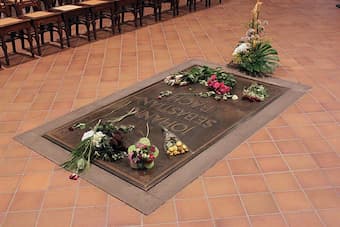
Grave of Bach in Leipzig
Johann Sebastian Bach was an eager student. He carefully worked through all the musical scores he could get his hands on. And we know that he studied music from the Renaissance, and particularly the music of Pierluigi Palestrina. For Christmas celebration in 1723, Bach composed the highly Italianate Magnificat for chorus and orchestra. Making sure that everybody would understand the festive nature of his setting, Bach employed a particularly large orchestra. We find three trumpets with drums, two flutes, two oboes, strings and continuo. He also uses a five-part chorus, together with a solo vocal quintet. It is difficult to think of another work that communicates such splendor and jubilation as Bach ingeniously exploits the spiritual and dramatic elements of the text. Coming in at No. 4 of this top 10 list is The Well-Tempered Clavier.
Johann Sebastian Bach: The Well-Tempered Clavier, Book 2, BWV 870-893 (excerpt) (Piotr Anderszewski, piano)
In the early 1720s, Bach set himself the task of composing a collection of a set of preludes and fugues in all 24 major and minor keys for solo keyboard. As he writes in the preface, it was composed “for the profit and use of musical youth desirous of learning, and especially for the pastime of those already skilled in this study.” For some reason Bach did not feel that he had inspired enough “desirous musical youth” so he put together a complete second set 20 years later! Today we know these two sets under the name Well-Tempered Clavier, and they are considered among the most important works in the history of classical music. Yet again, it isn’t simply a collection of technical and theoretical pieces, but an entire universe of different emotions and musical styles. Coming in at No. 3 in my list is the Concerto for 2 Violins in D minor.
Johann Sebastian Bach: Concerto for 2 Violins in D minor, BWV 1043

Goldberg Variations – Aria 1st edition
We earlier met Bach studying the Renaissance music of Palestrina. In the Concerto for 2 Violin Bach again looks to Italy, but this time to Antonio Vivaldi. A scholar writes, “this concerto presents the perfect synthesis of Bach’s confrontation with the Italianate simplicity and elegance of form and texture he learned from Vivaldi, and the intricate and perplexing density of counterpoint.” I am sure that this technical analysis is correct, but I completely forget about the musical nuts and bolts when I hear this piece. The opening ritornello is simply divine in expressions, and the slow movement takes as to a lush and dramatic Baroque opera. The final movement builds from a very short motific gesture, and it is truly unbelievable how much energy is contained in this short gesture and its development. I had some real trouble deciding what Bach composition would stand at the top of my list, and which one was going come in at No. 2. In the end, I decided that No. 2 would be the Goldberg Variations.
Johann Sebastian Bach: Goldberg Variations, BWV 988 (Glenn Gould, piano)
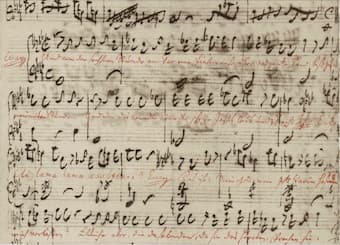
St. Matthew Passion
It’s probably true to say that every lover of classical music knows the Goldberg Variations. And many of us know the story of the insomniac count and his personal keyboard player who lent his name to one of the most remarkable compositions in the history of Western music. In the opening aria and thirty variations we find formal beauty and musical self-reflection alongside “an abundant display of modern and fashionable expressive elements of the high Baroque.” Glenn Gould wrote that the Goldberg Variations are “the most brilliant substantiation of a ground bass in history, as the music observes neither end nor beginning, neither real climax nor real resolution. But it does have unity through intuitive perception, unity born of craft and scrutiny, mellowed by mastery achieved, and revealed to us here, as so rarely in art, in the vision of subconscious design exulting upon a pinnacle of potency.” The only composition to improve on that, in my humble opinion, is the St. Matthew Passion, which comes in at the top of the class. I could go on and on trying to communicate the musical and emotional power of this composition, but Bach really said it all in his music. To me, it is simply a musical vision of eternity. Now you know my top 10 compositions by Johann Sebastian Bach; what are your favorites?
For more of the best in classical music, sign up to our E-Newsletter
Johann Sebastian Bach: St. Matthew Passion, BWV 244



I like Brandenburg no.5 more than no.4; the wonderful trio of violin, recorder, and harpsichord and one of the earliest if not earliest use of the harpsichord as a soloist. I prefer orchestral suite no.1 and no.2 over no.4 (btw overture to no.4 also appears in Cantata BWV 110). I would replace the Art of the Fugue with the chromatic fantasy and fugue. I would add the violin partita no.2 in d minor, St John Passion, Mass in b minor, several organ works and cantatas.
Given the importance of the organ both in his life and in his output (more than 20% of all BWV numbers), any sensible list should contain at least one work for organ.
Really enjoyed reading this, it’s an impossible task in my opinion you could have picked a different ten and it would still be valid in my eyes. One thing I certainly will agree on is Bach is the greatest of them all.
Wonderfully done. Cheers!
Thank you. But including YoYo kind of spoilt it for me. We cellists can’t but play the suites, because there is nothing like -as Bijlsma famously stated- having your bottom spanked by the Master, but they are not among His better works, not by a long shot, if we’re honest.